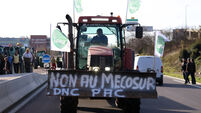The reins of law and order return
The decision of then prime minister Ted Heath, taken in a bid to control the worsening security situation, prompted the fall of the devolved administration, with unionist politicians resigning en mass in protest.
Ironic then that the long-running wrangle that preceded the return of the functions to Belfast, and nearly saw the current Assembly collapse, was in large part down to the hesitancy of the latest generation of unionists to back the move.
That apparent paradigm shift in position can only be explained in the context of the turbulent events and seismic political developments witnessed in the last four decades.
In 1972, Northern Ireland’s prime minister Brian Faulkner branded the decision to seize the reins of law and order as a “betrayal by London”.
With the Troubles at their height and the region teetering on the edge of outright civil war, Heath had felt it necessary to take sensitive policing decisions out of the hands of the unionist-ruled parliament.
The powers remained at Whitehall throughout the conflict and not until the peace process of the 1990s did the possibility surface of their return.
But by then the political landscape had altered dramatically.
The historic Good Friday Agreement of 1998 created a power-sharing administration with unionists and nationalists ruling alongside each other in a mandatory coalition government.
Whereas unionists had outright control of all decisions in the 50 years before 1972, from 1998 onward they could no longer govern without nationalist and republican co-operation.
To a community that had suffered at the hands of the IRA for 30 years, that raised the unpalatable prospect of Sinn Féin having control over the police – an organisation which lost more than 300 officers at the hands of republican terrorists in the Troubles.
With the IRA showing no readiness to give up its guns, the return of justice powers was a move too far for the region’s then largest unionist party – the Ulster Unionists.
So while the 1998 accord saw the majority of government functions devolved back to Stormont, law and order transfer was kicked into the long grass, with a commitment to re-examine the issue in the future.
However, in terms of the newly created Police Service of Northern Ireland, a degree of responsibility was vested back in local hands, with the setting up of the independent oversight body, the NI Policing Board in 2001.
At Stormont, the faltering administration stumbled on a number of occasions in the years after the Good Friday Agreement and by the time power-sharing was resurrected again in 2007, Sinn Féin and the DUP had displaced the SDLP and UUP as the largest parties within their respective communities.
The 2006 St Andrews Agreement between the British and Irish governments, which paved the way for the Assembly’s latest incarnation, required Sinn Féin to publicly sign up to support the police service for the first time.
It also envisaged the devolution of justice powers within two years of the restoration of the Executive.
After a honeymoon period when once-forsworn enemies DUP leader Ian Paisley and Sinn Féin’s Martin McGuinness struck up a surprisingly warm working relationship as first minister and deputy first minister respectively, the cracks started toappear when the thorny issue of policing powers again appeared on the horizon.
Only weeks after Peter Robinson took over from the retired Paisley in 2008, the Executive was plunged into a five-month deep freeze when Sinn Féin refused to attend Executive meetings until the DUP agreed to make progress on devolution.
To republicans, achieving the transfer was a highly symbolic step in proving to their electorate that it was them, not the British government, that made decisions for the region.
The impasse was finally broken in November of that year when the parties agreed a roadmap to achieving devolution.
Key elements included a commitment by both parties not to take up the new justice ministry in its first mandate, with the position instead occupied by a candidate that could command cross-community support in the Assembly.
Though it wasn’t stated, effectively this made the non-aligned Alliance Party the only viable incumbent.
Another pre-requisite stipulated by the DUP was the need to prove there was sufficient confidence within the community to justify the transfer.
Much of the debate from then until the DUP and Sinn Féin finally agreed a date for transfer at Hillsborough Castle in February focused on this hard-to-define concept.
In the event, the backing of Robinson and his colleagues was only secured after they obtained concessions on how contentious loyal order parades would be managed in the future.
Meanwhile, Faulkner’s direct descendants in the UUP still oppose the move, claiming the Executive is not mature enough to take on the extra responsibilities.
Hardliners the Traditional Unionist Voice party go even further, portraying the decision of the DUP as a betrayal of their core values.
And so 38 years on, the leaders of unionism find themselves denounced for retrieving something their forebears fell on their swords in a bid to hang on to.
Without the prism of historical perspective, it would be a hard one to understand.













